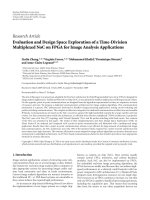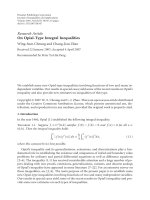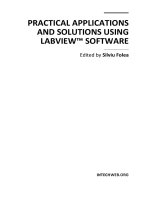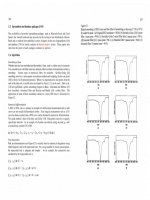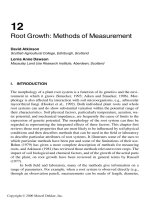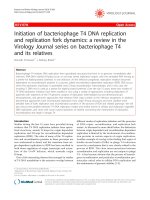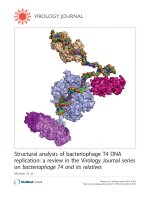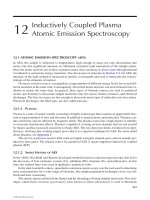(Series on analysis, applications and computation 12) wing sum cheung metric space topology examples, exercises and solutions (2023)
Bạn đang xem bản rút gọn của tài liệu. Xem và tải ngay bản đầy đủ của tài liệu tại đây (11.9 MB, 442 trang )
Series on Analysis, Applications and Computation – Vol. 12
ISAAC
Series on Analysis, Applications and Computation
ISSN: 1793-4702
Series Editors: Heinrich G W Begehr (Freie Univ. Berlin, Germany)
Robert Pertsch Gilbert (Univ. Delaware, USA)
Tao Qian (Univ. of Macau, China)
M W Wong (York Univ., Canada)
Advisory Board Members:
Mikhail S Agranovich (Moscow Inst. of Elec. & Math.,
Ryuichi Ashino (Osaka Kyoiku Univ., Japan), Russia),
Alain Bourgeat (Univ. de Lyon, France),
Victor Burenkov (Cardiff Univ., UK),
Jinyuan Du (Wuhan Univ., China),
Antonio Fasano (Univ. di Firenez, Italy),
Massimo Lanza de Cristoforis (Univ. di Padova, Italy),
Bert-Wolfgang Schulze (Univ. Potsdam, Germany),
Masahiro Yamamoto (Univ. of Tokyo, Japan) &
Armand Wirgin (CNRS-Marseille, France)
Published
Vol. 12: Metric Space Topology: Examples, Exercises and Solutions
by W-S Cheung
Vol. 11: Hardy Operators on Euclidean Spaces and Related Topics
by S Lu, Z Fu, F Zhao & S Shi
Vol. 10: Fractional Differential Equations and Inclusions:
Classical and Advanced Topics
by S Abbas, M Benchohra, J E Lazreg, J J Nieto & Y Zhou
Vol. 9: Nonlinear Waves: A Geometrical Approach
by P Popivanov & A Slavova
Vol. 8: The Linearised Dam-Break Problem
by D J Needham, S McGovern & J A Leach
Vol. 7: The “Golden” Non-Euclidean Geometry: Hilbert’s Fourth Problem,
“Golden” Dynamical Systems, and the Fine-Structure Constant
by A Stakhov & S Aranson, Assisted by S Olsen
Vol. 6: An Introduction to Pseudo-Differential Operators
Third Edition
by M W Wong
Vol. 5: Asymptotic Behavior of Generalized Functions
by S Pilipović, B Stanković & J Vindas
More information on this series can be found at />
Series on Analysis, Applications and Computation – Vol. 12
ISAAC
World Scientific
Published by
World Scientific Publishing Co. Pte. Ltd.
5 Toh Tuck Link, Singapore 596224
USA office: 27 Warren Street, Suite 401-402, Hackensack, NJ 07601
UK office: 57 Shelton Street, Covent Garden, London WC2H 9HE
Library of Congress Cataloging-in-Publication Data
Names: Cheung, Wing-Sum (Mathematician), author.
Title: Metric space topology : examples, exercises and solutions /
Wing-Sum Cheung, the University of Hong Kong, Hong Kong.
Description: New Jersey : World Scientific, [2024] | Series: Series on analysis, applications
and computation, 1793-4702 ; Vol. 12 | Includes bibliographical references and index.
Identifiers: LCCN 2023023176 | ISBN 9789811266973 (hardcover) |
ISBN 9789811266980 (ebook for institutions) | ISBN 9789811266997 (ebook for individuals)
Subjects: LCSH: Metric spaces--Problems, exercises, etc.
Classification: LCC QA611.28 .C44 2024 | DDC 514/.325--dc23/eng20230919
LC record available at />
British Library Cataloguing-in-Publication Data
A catalogue record for this book is available from the British Library.
Copyright © 2024 by World Scientific Publishing Co. Pte. Ltd.
All rights reserved. This book, or parts thereof, may not be reproduced in any form or by any means,
electronic or mechanical, including photocopying, recording or any information storage and retrieval
system now known or to be invented, without written permission from the publisher.
For photocopying of material in this volume, please pay a copying fee through the Copyright Clearance
Center, Inc., 222 Rosewood Drive, Danvers, MA 01923, USA. In this case permission to photocopy
is not required from the publisher.
For any available supplementary material, please visit
/>
Desk Editors: Nimal Koliyat/Lai Fun Kwong
Typeset by Stallion Press
Email:
Printed in Singapore
To my parents
in heaven
This page intentionally left blank
Preface
This is a volume on the Topology of Metric Spaces, which is a sub-
ject the author has been teaching in the last couple of decades. It
can serve as a textbook or a reference on the subject concerned,
mainly for advanced level undergraduates concentrating on
Mathematics, Physics, Economics and Finance, etc. A common
serious drawback of most existing references/textbooks at this level
is the lack of worked examples/exercises with detailed solutions. So
the readers are frequently frustrated for not being able to solve the
exercises or not being able to tell whether their solutions are valid.
To overcome this drawback, it is the purpose of the present
volume to provide plenty of worked examples and exercises,
including True-or-False type questions and open-ended questions,
with detailed solutions. True-or-False type questions and open-ended
questions are particularly effective in helping the readers to get a
birds eye view of the subject and to master the materials. They
are also instrumental in nurturing the mathematical insight and the
mathematical maturity of the readers.
The emphasis of most standard textbooks or reference books
on the subject is the abstract and theoretical aspect, but such an
approach may not be readily digestible by most readers. In
order to master a new concept, it is most effective to first keep
in mind a few simple, concrete and familiar examples, and then
when dealing with a problem in the general setting, consider first
the problem in such simple concrete settings. In many situations,
the treatment of a problem in a simple setting could serve as a clue
to tackle the problem in the general setting. On the other hand,
pictorization or visualization of abstract problems into simple
pictures is very often instrumental to the rigorous treatment of the
problems. However, this is rarely provided in most standard
vii
viii Metric Space Topology: Examples, Exercises and Solutions
references. In view of this, in this volume, within each section in
each chapter, blended with the concise and rigorous treatments on
the materials and before tackling problems in the more abstract
settings, there will be a number of concrete examples/exercises,
supplemented with simple pictorizations as appropriate, to help the
readers master the concepts.
The learning outcomes of the volume include:
• Demonstrate knowledge and understanding of the basic
features of mathematical analysis and point set topology (e.g.,
able to identify objects that are topologically equivalent).
• Apply knowledge and skills acquired in mathematical
analysis to analyze and handle novel situations in a critical way
(e.g., able to determine whether a specific function is uniformly
continuous).
• Think creatively and laterally to generate innovative examples
and solutions to non-standard problems (e.g., able to construct
counterexamples to inaccurate mathematical statements).
• Acquire sufficient background for further studies in Functional
Analysis, Real Analysis, Complex Analysis, Differential and
Algebraic Geometry, Probability Theory, Mathematical
Physics, Engineering, Economics and Finance, etc.
Throughout the 30+ years of teaching experience of the author, the
most frequently asked question is “What is the use of the subject?”
To be absolutely frank, many branches of pure mathematics do not
find any direct application in the real world whatsoever. In fact,
except for a small portion of the students who would go on for
further studies and take mathematics research as their careers,
most theorems or results they have learnt in their mathematics
courses will not be seen or used for the rest of their lives. So it is
perfectly fine for them to forget all the mathematics contents they
have learnt at school or in college. But one thing they should
never forget is the study process of and the way of thinking in
Preface ix
mathematics, that is, the mathematics training they have
undergone. It is not the mathematical contents they have learnt that
are important but the mathematics training they received. Proper
mathematics training nurtures logical arguments, analytical power,
critical thinking, and rational thinking. With these attributes, one
could excel in any career one may go into. So the target of this
volume is, through numerous worked examples and exercises, to
guide the readers argue logically, think critically, analyze various
possible scenarios, and to nurture a mathematical and logical mind
that is able to tackle novel and ill-posed problems they may encounter
in the future. With that, the so-called life long self-learning would
no longer be a burden but instead, would turn into a basic instinct.
The volume is perfect as a textbook or a reference for a one-
semester course on Introduction to Metric Space Topology. It is the
intention of the author to make it concise instead of stuffing it with
unessential materials, as the latter may distract the readers from the
natural flow of the development of the subject. Less is more. For
advanced undergraduate level students, mastering the central theme
of a subject would be much more beneficial than dabbling in a wider
range of materials shallowly and prematurely.
Finally, the author would like to express his gratitude to the
many students who have taken his course on the subject. Their
enthusiastic comments and feedback on the teaching materials have
provided strong incentive for his determination to write up this book.
The professional assistance rendered by the staff of World Scientific,
especially Lai Fun Kwong, is also gratefully acknowledged.
This page intentionally left blank
A Note on the Convention
There are two different conventions for the notations of
“subset” and “proper subset”. In this volume, we will be
exclusively adopting the following convention:
A is an arbitrary subset of X : A ⊂ X
A is a proper subset of X : A X
xi
This page intentionally left blank
About the Author
Wing-Sum Cheung was a full Professor of the Department of
Mathematics of the University of Hong Kong before he retired in
2022. He is currently the Director of Undergraduate Admissions of
the Faculty of Science and an Honorary Professor of the Department
of Mathematics of the University of Hong Kong. He holds a BSc
(with 1st class honors) from the Chinese University of Hong Kong, an
MA and a PhD from Harvard University, USA. He has served as Head
of Department of Mathematics and Associate Dean of the Faculty of
Science of the University of Hong Kong, Vice-President of the Hong
Kong Mathematical Society, Council Member of the Southeast Asian
Mathematical Society, Council Member of the Hong Kong Institute of
Science, Leader of the Hong Kong International Olympiad Team, and
Honorary Consultant of the Ministry of Education, Youth and Sports
of the Government of Cambodia. He has published over 200 journal
articles, conference proceedings and book chapters, in which over
140 appeared in ISI journals. He has been named a top 1% highly
cited researcher in the world by Clarivate Analytics’ Essential Science
Indicator for 6 times in the last decade. He is on the editorial board of
a number of international mathematical journals including Abstract
xiii
xiv Metric Space Topology: Examples, Exercises and Solutions
and Applied Analysis, Asian European Journal of Mathematics, Far
East Journal of Mathematical Sciences, Journal of Inequalities and
Applications, etc. His current research interests include Differen-
tial Geometry, Exterior Differential Systems, Calculus of Variations,
Analytic Inequalities, and Differential Equations.
Contents
Preface vii
A Note on the Convention xi
About the Author xiii
1. Metric Spaces 1
1.1 Definitions and Examples . . . . . . . . . . . . . . . . . . 1
Exercise 1.1: Part A . . . . . . . . . . . . . . . . 10
Exercise 1.1: Part B . . . . . . . . . . . . . . . . 14
1.2 Topology of Metric Spaces . . . . . . . . . . . . . . . . . . 36
Exercise 1.2: Part A . . . . . . . . . . . . . . . . 50
Exercise 1.2: Part B . . . . . . . . . . . . . . . . 64
1.3 Compactness . . . . . . . . . . . . . . . . . . . . . . . . . 85
Exercise 1.3: Part A . . . . . . . . . . . . . . . . 90
Exercise 1.3: Part B . . . . . . . . . . . . . . . . 94
1.4 Compactness in the Euclidean Space Rn . . . . . . . . . . 108
Exercise 1.4: Part A . . . . . . . . . . . . . . . . 115
Exercise 1.4: Part B . . . . . . . . . . . . . . . . 118
2. Limits and Continuity 129
2.1 Convergence in a Metric Space . . . . . . . . . . . . . . . 129
Exercise 2.1: Part A . . . . . . . . . . . . . . . . 134
Exercise 2.1: Part B . . . . . . . . . . . . . . . . 138
2.2 Complete Metric Spaces . . . . . . . . . . . . . . . . . . . 145
Exercise 2.2: Part A . . . . . . . . . . . . . . . . 150
Exercise 2.2: Part B . . . . . . . . . . . . . . . . 155
2.3 Continuity and Homeomorphism . . . . . . . . . . . . . . 172
Exercise 2.3: Part A . . . . . . . . . . . . . . . . 193
Exercise 2.3: Part B . . . . . . . . . . . . . . . . 204
3. Connectedness 233
3.1 Connectedness . . . . . . . . . . . . . . . . . . . . . . . . 233
Exercise 3.1: Part A . . . . . . . . . . . . . . . . 245
Exercise 3.1: Part B . . . . . . . . . . . . . . . . 249
xv
xvi Metric Space Topology: Examples, Exercises and Solutions
3.2 Path-connectedness . . . . . . . . . . . . . . . . . . . . . . 266
Exercise 3.2: Part A . . . . . . . . . . . . . . . . 278
Exercise 3.2: Part B . . . . . . . . . . . . . . . . 281
4. Uniform Continuity 295
4.1 Uniform Continuity . . . . . . . . . . . . . . . . . . . . . . 296
Exercise 4.1: Part A . . . . . . . . . . . . . . . . 301
Exercise 4.1: Part B . . . . . . . . . . . . . . . . 309
4.2 Contraction and Banach’s Fixed Point Theorem . . . . . 322
Exercise 4.2: Part A . . . . . . . . . . . . . . . . 330
Exercise 4.2: Part B . . . . . . . . . . . . . . . . 332
5. Uniform Convergence 349
5.1 Sequence of Functions . . . . . . . . . . . . . . . . . . . . 349
Exercise 5.1: Part A . . . . . . . . . . . . . . . . 368
Exercise 5.1: Part B . . . . . . . . . . . . . . . . 377
5.2 Series of Functions . . . . . . . . . . . . . . . . . . . . . . 389
Exercise 5.2: Part A . . . . . . . . . . . . . . . . 395
Exercise 5.2: Part B . . . . . . . . . . . . . . . . 401
Bibliography 421
Index 423
Chapter 1
Metric Spaces
In this chapter, the basic concept of metric spaces will be introduced.
Naively, they are simply nonempty sets equipped with a structure
called metric. For the less matured students, at the beginning, this
structure may appear to be a bit abstract and difficult to master.
But in practice, this seemingly new concept is nothing more than
a tiny little abstractization of the familiar space Rn and so all one
needs to do is that whenever one needs to work on a problem in an
abstract metric space, one first looks at the problem on Rn, then one
would be able to see the clue of how to proceed in the general case.
In fact, in general, the most effective way to master a new concept
in any branch of mathematics is to keep in mind a couple of typical
concrete examples and think of these examples all the time. It is just
that easy.
1.1 Definitions and Examples
Definition 1.1.1. Let X be a nonempty set. A metric on X is a
real-valued function
d:X×X →R
satisfying
(M1) d(x, y) ≥ 0 and d(x, y) = 0 if and only if x = y,
(M2) (symmetry) d(x, y) = d(y, x),
(M3) (triangle inequality) d(x, y) ≤ d(x, z) + d(z, y)
for all x, y, z ∈ X. Given x, y ∈ X, d(x, y) is also known as the
distance between x and y with respect to d. The pair (X, d) is called
a metric space and elements in X are referred to as points in X. For
the sake of convenience, in case there is a clearly defined metric d on
X, we shall simply call X a metric space.
1
2 Metric Space Topology: Examples, Exercises and Solutions
Example 1.1.2.
(i) Let X := {a, b, c}, consider d1, d2, and d3 : X ×X → R given by
d1 a b c d2 a b c d3 a b c
a 023 a 012 a 012
b 204 b 103 b 104
c 340 ;c 230 ;c 240 .
Then d1 and d2 are well-defined metrics on X but d3 is not
(why?)
(ii) Let X be any nonempty set and d(x, y) := 1 − δxy for any x,
y ∈ X, where δxy is the Kronecker delta function defined by
δxy := 0 if x = y
1 if x = y .
Then d is a well-defined metric called the discrete metric and
(X, d) is called a discrete metric space. Notice that in a discrete
metric space, all distinct points have the same distance 1, no
matter how “far” or “close” they are from each other.
(iii) Let X := Rn and de(x, y) := x − y for any x, y ∈ Rn, where
as usual, stands for the Euclidean norm of Rn, that is,
n z2 ∈ Rn.
z := i for any z = (z1, . . . , zn) Hence
i=1
de(x, y) = n
(xi − yi)2
i=1
for any x = (x1, . . . , xn), y = (y1, . . . , yn) ∈ Rn. Then de is
a well-defined metric called the Euclidean metric on Rn and
(Rn, de) is called a Euclidean metric space. In general, when
we refer to the “Euclidean space Rn”, we mean the Euclidean
metric space (Rn, de). In the sequel, unless it is specifically
mentioned, all Rn’s will be equipped with the Euclidean metric
de and so sometimes we will be sloppy and write d for de and
Rn for (Rn, de) in case no confusion may arise.
Metric Spaces 3
(iv) Let X := C and dC(x, y) := |x − y| for any x, y ∈ C, where, as
usual, |z| := the modulus of z ∈ C. Then dC is a well-defined
metric, and we will see that (C, dC) is “equivalent” to the
Euclidean space (R2, de). In fact, it is easy to see that under the
usual identification C ∼= R2, any x, y ∈ C can be considered as
points in R2, and under this identification, dC(x, y) = de(x, y).
(v) Let X := R2 and d˜(x, y) := 100(x1 − y1)2 + (x2 − y2)2 for
any x = (x1, x2) and y = (y1, y2) ∈ R2. Then d˜ is a well-defined
metric on X. Note that as real-valued functions of X × X into
R, d˜ = de .
(vi) Let X := S1 ⊂ R2 and d(x, y) := the arc length of the smaller arc
in S1 joining x and y ∈ X. Then d is a well-defined metric on X.
Note that d = de as real-valued functions of X × X into R. This
is a typical example of “intrinsic metric” that can be defined on a
metric space. It is called intrinsic as the distance between two
points can be measured without referring to the ambient space
R2. In fact, imagine you are an ant walking on a rubber band.
Then for you, the “distance” between two points A, B on the
rubber band is d(A, B) instead of de(A, B), because the latter is
the Euclidean distance between the two points A, B which is
attained by the straight line segment joining the two points, but
for you, the ant, unless you can fly, you cannot travel from A to B
along the straight line segment joining the two points.
(vii) Let X := S2 ⊂ R3 and x, y ∈ X. Observe that if x = ±y, then
there is a unique “great circle” on X passing through x, y.
Here, a great circle means a planar circle on S2 with radius 1.
Define d(x, y) := the arc length of the smaller arc on the
unique great circle in S2 joining x and y. If x = y, we
define d(x, y) := 0. Finally, if x = −y, then they are antipodal
points on S2 and so they are joined by infinitely many great
circles. In this case we define d(x, y) := π = half of the arc
length of any such great circles. Then, similar to Example (vi),
d is a well-defined intrinsic metric on X.

